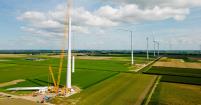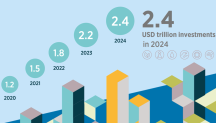

Tripling Renewables by 2030 Requires a Minimum of 16.4% Annual Growth Rate
Newsletter
Record growth in renewables must be significantly topped up in the remaining 7 years to meet the UAE Consensus energy target set at COP28
Abu Dhabi, United Arab Emirates, 11 July 2024 – The Renewable Energy Statistics 2024 released by the International Renewable Energy Agency (IRENA) today shows that despite renewables becoming the fastest growing source of power, the world risks missing the tripling renewables target pledged at COP28. To stay the course, the world will now have to grow renewables capacity at a minimum 16.4% rate annually through 2030.
The unprecedented 14% increase of renewables capacity during 2023 established a 10% compound annual growth rate (2017-2023). Combined with the constant decreasing additions of non-renewable capacity over the years, the trend sees renewable energy on its way to overtake fossil fuels in global installed power capacity.
However, if last year’s 14% increase rate continues, the tripling target of 11.2 Terawatts (TW) in 2030 outlined by IRENA’s 1.5°C Scenario will fall 1.5 TW short, missing the target by 13.5%. Furthermore, if the world keeps the historic annual growth rate of 10%, it will only accumulate 7.5 TW of renewables capacity by 2030, missing the target by almost one-third.
IRENA Director-General, Francesco La Camera said, “Renewable energy has been increasingly outperforming fossil fuels, but it is not the time to be complacent. Renewables must grow at higher speed and scale. Our new report sheds light on the direction of travel; if we continue with the current growth rate, we will only face failure in reaching the tripling renewables target agreed in the UAE Consensus at COP28, consequently risking the goals of the Paris Agreement and 2030 Agenda for Sustainable Development.”
“As custodian agency tasked with monitoring the progress, IRENA is committed to support countries in their pathways to meet the target, but we need concrete policy actions and massive mobilisation of finance at full speed to reach our destination together.”
“Consolidated global figures conceal ongoing patterns of concentration in geography. These patterns threaten to exacerbate the decarbonisation divide and pose a significant barrier to achieving the tripling target,” he added.
“Today’s report is a wake-up call for the entire world: while we are making progress, we are off track to meet the global goal of tripling renewable energy capacity to 11.2 TW by 2030. We need to increase the pace and scale of development.”
COP28 President Dr Sultan Al Jaber said, “That means increasing collaboration between governments, the private sector, multilateral organisations, and civil society. Governments need to set explicit renewable energy targets, look at actions like accelerating permitting and expanding grid connections, and implement smart policies that push industries to step up and incentivise the private sector to invest. Additionally, this moment provides a significant opportunity to add strong national energy targets in NDCs to support the global goal of keeping the 1.5°C target within reach. Above all, we must change the narrative that climate investment is a burden to it being an unprecedented opportunity for shared socio-economic development.”
In terms of power generation, the latest data available for 2022 confirmed yet again the regional disparity in renewables deployment. Asia holds its position as leader in the global renewable power generation with 3 749 Terawatt hours (TWh), followed for the first time by North America (1 493 TWh). The most impressive jump occurred in South America, where renewable power generation increased by nearly 12% to 940 TWh, due to a hydropower recovery and a greater role of solar energy.
With a modest growth of 3.5%, Africa increased its renewable power generation to 205 TWh in 2022, despite the continent’s tremendous potential and immense need for rapid, sustainable growth. Acknowledging the urgent need for support and finance, IRENA is advancing the Accelerated Partnership for Renewables in Africa (APRA) initiative and is preparing an investment forum focused on APRA’s member countries later this year.
Read the full Renewable Energy Statistics 2024 including the highlights, here.






